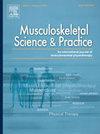年轻扁平足患者站立和动态活动时的姿势稳定性是否发生改变:一项比较研究
IF 2.2
3区 医学
Q1 REHABILITATION
引用次数: 0
摘要
据报道,与正常足部姿势(NF)的人相比,扁平足患者的站立姿势稳定性较差。然而,平足患者在坐立转换、上下踏步和沿直线行走等动态任务中是否会改变姿势稳定性尚不清楚。目的比较青年平足和NF患者静态站立和动态任务时的姿势稳定性。设计:病例对照研究。方法选取25例柔性扁平足患者和25例NF患者。使用NeuroCom Balance Master评估体位稳定性。获得两足站立和单足站立睁眼和闭眼时的摇摆速度值(度/秒)。得到了坐立试验的重量传递时间(秒)、上升指数(%体重)和摇摆速度(度/秒)参数,双人步行试验的速度(厘米/秒)和结束摇摆(度/秒)参数,跨步试验的上升指数(%体重)、运动时间(秒)和冲击指数(%体重)参数。结果平足组站立姿势稳定性较差,效应大小中等(p <;0.05, Cohen’s d = 0.66)。平足组串联行走速度和左右抬力较低,效应量大(p <;0.05, Cohen’s d分别= 1.33、1.01、0.97)。结论平足组静态和动态姿势稳定性较差,动态状态下影响更大。可能的下肢同心肌力量值得进一步研究。本文章由计算机程序翻译,如有差异,请以英文原文为准。
Is postural stability during standing and dynamic tasks altered in young adults with flatfoot: A comparison study
Background
People with flatfoot were reported to exhibit poorer standing postural stability than those with normal foot posture (NF). However, whether postural stability is altered during dynamic tasks including sit-to-stand transition, step-up/down, and walking along a line in people with flatfoot is not clarified.
Objectives
To compare postural stability during static standing and dynamic tasks between young adults with flatfoot and NF.
Design
A case-control study.
Method
Twenty-five people with flexible flatfoot and twenty-five people with NF were included. Postural stability was assessed using the NeuroCom Balance Master. Sway velocity values (deg/sec) during bipedal and unipedal standing with eyes-open and eyes-closed were obtained. The weight transfer time (sec), rising index (% body weight), and sway velocity (deg/sec) parameters of the sit-to-stand test, the speed (cm/sec) and end sway (deg/sec) parameters of the tandem walk test, and the lift-up index (% body weight), movement time (sec), and impact index (% body weight) parameters of the step-up-over test were obtained.
Results
Standing postural stability was poorer in the flatfoot group with a moderate effect size (p < 0.05, Cohen's d = 0.66). The speed during tandem walking and left and right lift-up forces were lower in the flatfoot group with large effect sizes (p < 0.05, Cohen's d = 1.33, 1.01, and 0.97, respectively).
Conclusions
The flatfoot group exhibited poorer static and dynamic postural stability, with larger effects observed in dynamic conditions. Possible lower concentric muscle strength of the lower extremity warrants further investigation.
求助全文
通过发布文献求助,成功后即可免费获取论文全文。
去求助
来源期刊

Musculoskeletal Science and Practice
Health Professions-Physical Therapy, Sports Therapy and Rehabilitation
CiteScore
4.10
自引率
8.70%
发文量
152
审稿时长
48 days
期刊介绍:
Musculoskeletal Science & Practice, international journal of musculoskeletal physiotherapy, is a peer-reviewed international journal (previously Manual Therapy), publishing high quality original research, review and Masterclass articles that contribute to improving the clinical understanding of appropriate care processes for musculoskeletal disorders. The journal publishes articles that influence or add to the body of evidence on diagnostic and therapeutic processes, patient centered care, guidelines for musculoskeletal therapeutics and theoretical models that support developments in assessment, diagnosis, clinical reasoning and interventions.
 求助内容:
求助内容: 应助结果提醒方式:
应助结果提醒方式:


